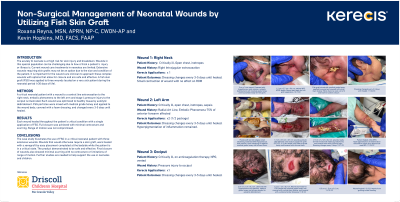Case Series/Study
(CS-124) Non-Surgical Management of Neonatal Wounds by Utilizing Fish Skin Graft

The acutely ill neonate is at high risk for skin injury and breakdown. Wounds in this special population can be challenging to heal due to how critical a patient’s injury or illness is. Current wound care treatments in neonates are limited. Extensive wounds requiring a skin graft may not be an option for treatment due to the size and condition of the patient. It is important for the wound care clinician to approach these complex wounds with options that allow for closure and are safe and effective. In this case study, a fish skin graft (FSG) was applied to three wounds located on a very sick patient during the neonatal period (< 30 days of life).
Methods:
A critical neonatal patient with a wound to a central line extravasation to the right neck, embolic phenomena to the left arm and stage 4 pressure injury to the occiput is illustrated. Each wound was optimized to healthy tissue by autolytic debridement. FSG particles were mixed with medical grade honey and applied to the wound beds, covered with a foam dressing, and changed every 3-5 days until healed.
Results:
Each wound healed throughout the patient’s critical condition with a single application of FSG. Full closure was achieved with minimal contracture and scarring. Range of motion was not compromised.
Discussion:
The case study illustrates the use of FSG in a critical neonatal patient with three extensive wounds. Wounds that would otherwise require a skin graft, were healed with a xenograft by easy placement completed at the bedside while the patient is in a critical state. The product demonstrated to be safe and effective. Final closure of wounds also showed minimal scarring with no contracture or limitations of range of motion. Further studies are needed to help support the use in neonates and children.
Trademarked Items:
References: 1.Ciprandi, G., Kjartansson, H., Grussu, F., Baldursson, B. T., Frattaroli, J., Urbani, U., & Zama, M. (2022). Use of acellular intact fish skin grafts in treating acute paediatric wounds during the COVID-19 pandemic: a case series. Journal of wound care, 31(10), 824–831.
https://doi.org/10.12968/jowc.2022.31.10.824
2.Stone R 2nd, Saathoff EC, Larson DA, Wall JT, Wienandt NA, Magnusson S, Kjartansson H, Natesan S, Christy RJ. Accelerated Wound Closure of Deep Partial Thickness Burns with Acellular Fish Skin Graft. Int J Mol Sci. 2021 Feb 4;22(4):1590. doi: 10.3390/ijms22041590. PMID: 33557424; PMCID: PMC7915828.
3.Wallner, C., Holtermann, J., Drysch, M., Schmidt, S., Reinkemeier, F., Wagner, J. M., ... & Behr, B. (2022). The Use of Intact Fish Skin as a Novel Treatment Method for Deep Dermal Burns Following Enzymatic Debridement: A Retrospective Case-Control Study. European Burn Journal, 3(1), 43-55.

.png)